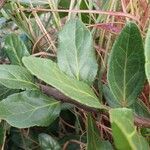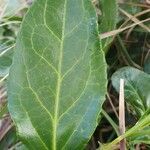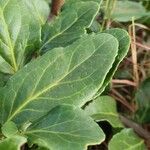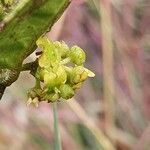Shrub or tree, up to 4 m high. Branchlets flattened, yellowish hairy, becoming terete and glabrous. Leaves alternate, yellowish hairy only on veins to densely hairy all over, dark green and glossy, paler and dull below; lamina ovate to lanceolate, 16-120(-150) x 8-56(-80) mm, base cuneate to cordate, apex obtuse, or rounded to emarginate, margins entire or wavy to glandular-toothed; petioles 4-8 mm long, hairy. Inflorescences axillary, cymose; peduncles up to 20 mm long, hairy. Flowers 5-merous, green to yellow; pedicels up to 15 mm long. Sepals ± suborbicular, ± 1 mm long, hairy. Petals suborbicular, 1-2 mm long, glabrous. Ovary (2)3-locular. Fruit a globose drupe, 8-20 mm in diam., often apiculate, bright to purplish red, smooth, glabrous or hairy.
Leaves with lamina dark green often glossy and sometimes glaucous above, paler and dull below, 1·6–12(15) × 0·8–5·6(8) cm., ovate to lanceolate or oblong or more rarely elliptic to subcircular, obtuse or very rarely acute to rounded or retuse at the apex, with margin entire or undulate-crenulate to glandular-denticulate, cuneate to shallowly cordate at the base, coriaceous, glabrous or with nerves shortly yellowish-pubescent above, glabrous or ± densely yellowish-pubescent to-velutinous below, with veins varying in prominence; petiole 1–8 mm. long, glabrous to velutinous.
An evergreen tree. It has several stems and grows 12 m tall. The crown is spreading. The young bark is smooth and grey but it becomes rough. The young branches are flattened. The leaves are dark green. They are simple and arranged in spirals. The flowers are in sprays with about 20 flowers. The fruit is fleshy with a stone inside. It is about 1 cm long and has a sweet edible pulp.
Shrub or tree (1)2–12(18) m. high; branches flattened (or very rarely somewhat angular) and yellowish-velutinous to sparsely puberulous or rarely glabrous when young, becoming terete and glabrous.
Cymes with peduncle up to 14(20) mm. long or rarely absent, glabrous or pubescent, varying in thickness; pedicels up to 15 mm. long; flowers 1-c. 20 in each cyme, 3–6 mm. in diam.
Drupe bright red to purplish-red, 8–20 mm., globose to ovoid, often apiculate, smooth or finely rugose, ± fleshy, glabrous or glaucous to puberulous.
Scrambling shrub or tree. Leaves elliptic to circular, often densely pubescent. Flowers in axillary glomerules, yellow. Drupe light brown.
Petals green to yellow, 1–2·5 mm. long, sub-circular and sessile or broadly unguiculate with short lamina, glabrous.
Sepals 0·5–1 mm. long, broadly ovate to semicircular, pubescent or puberulous or very rarely glabrous.
Stamens with anther-connective often reddish when dry.
Ovary broadly ovoid to semi-globose, (2)3-locular.





